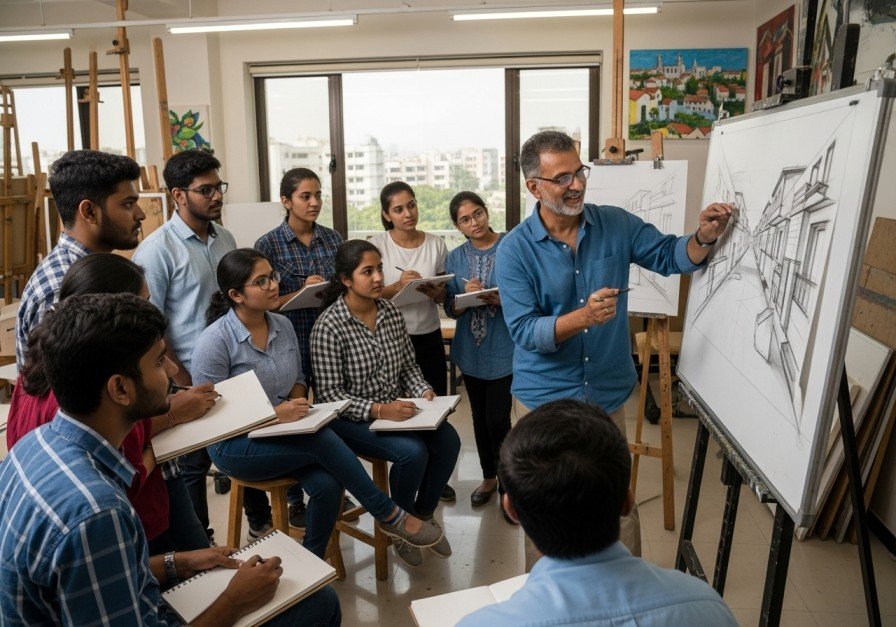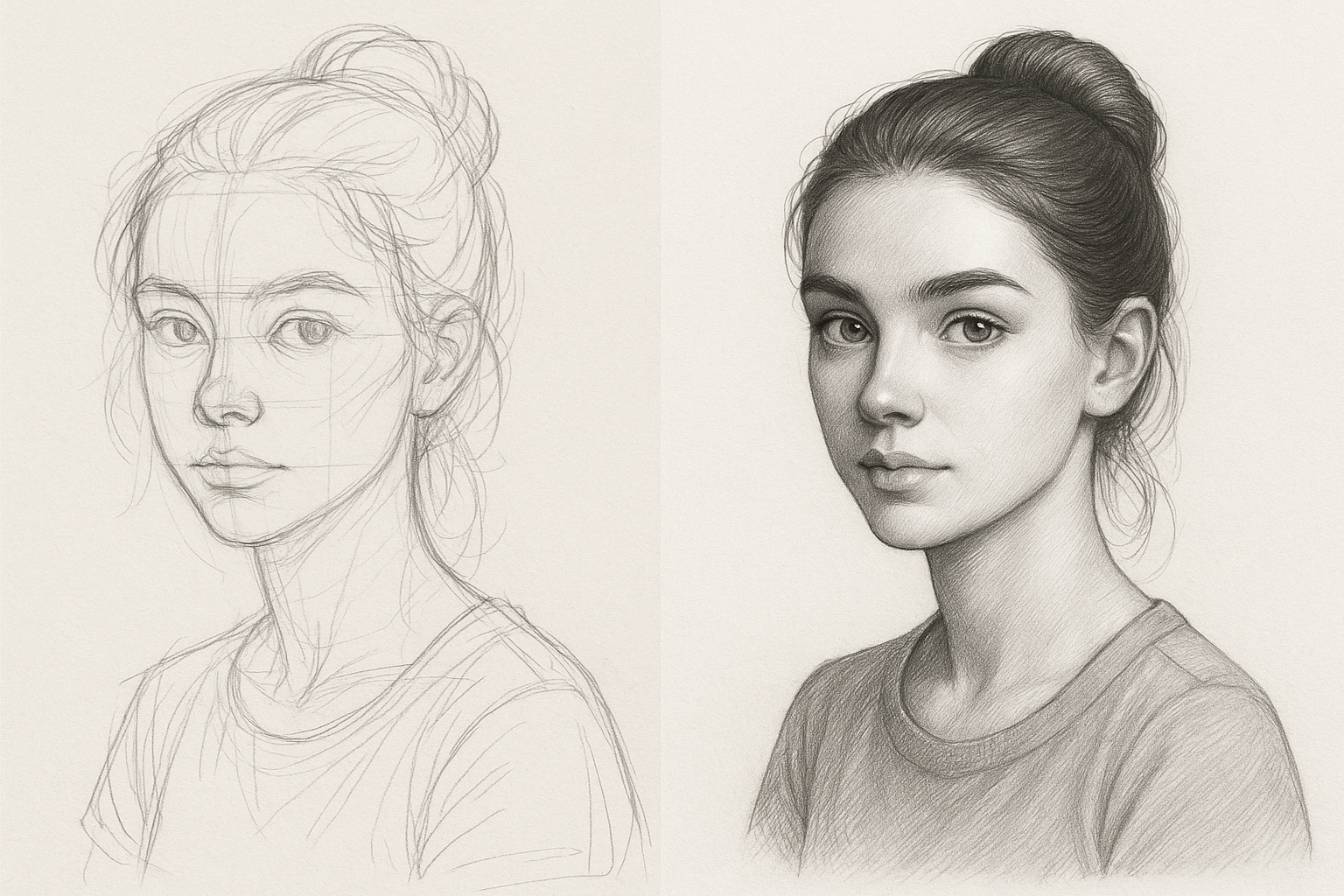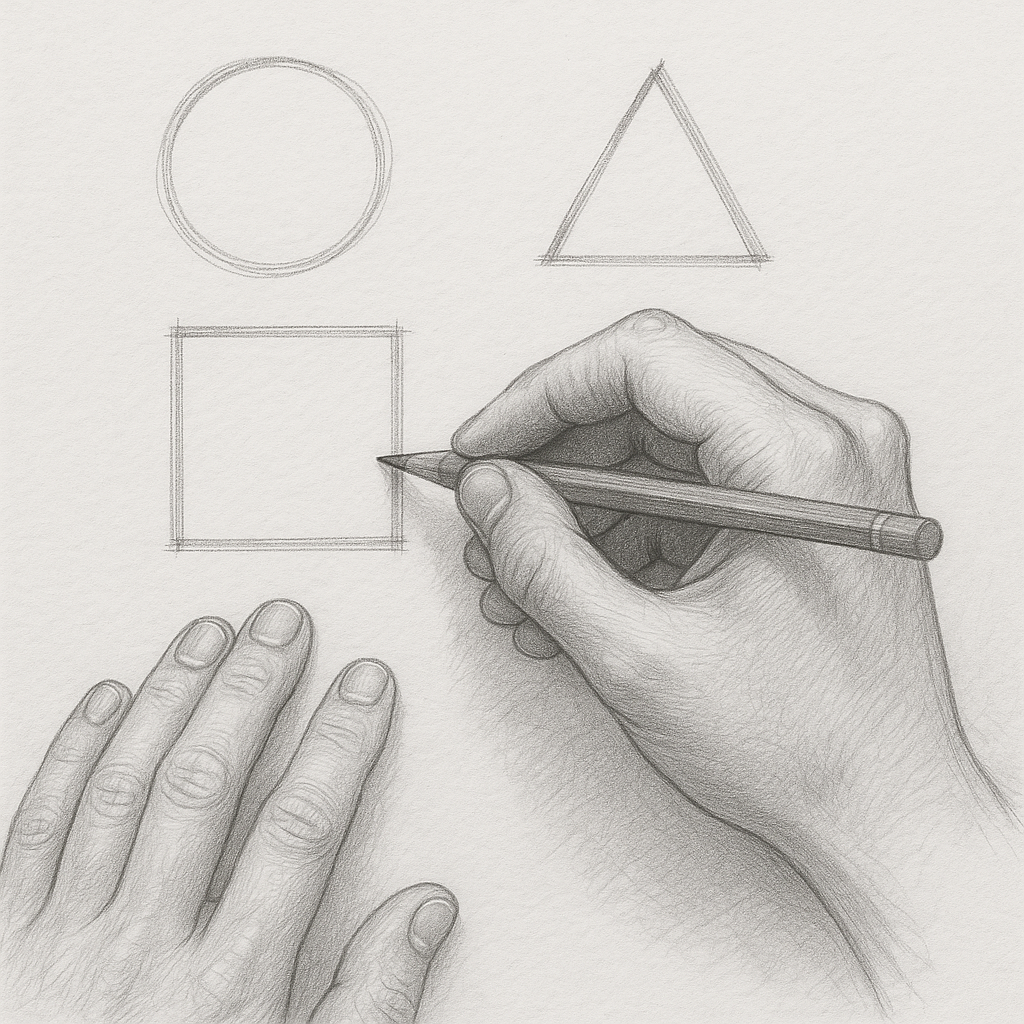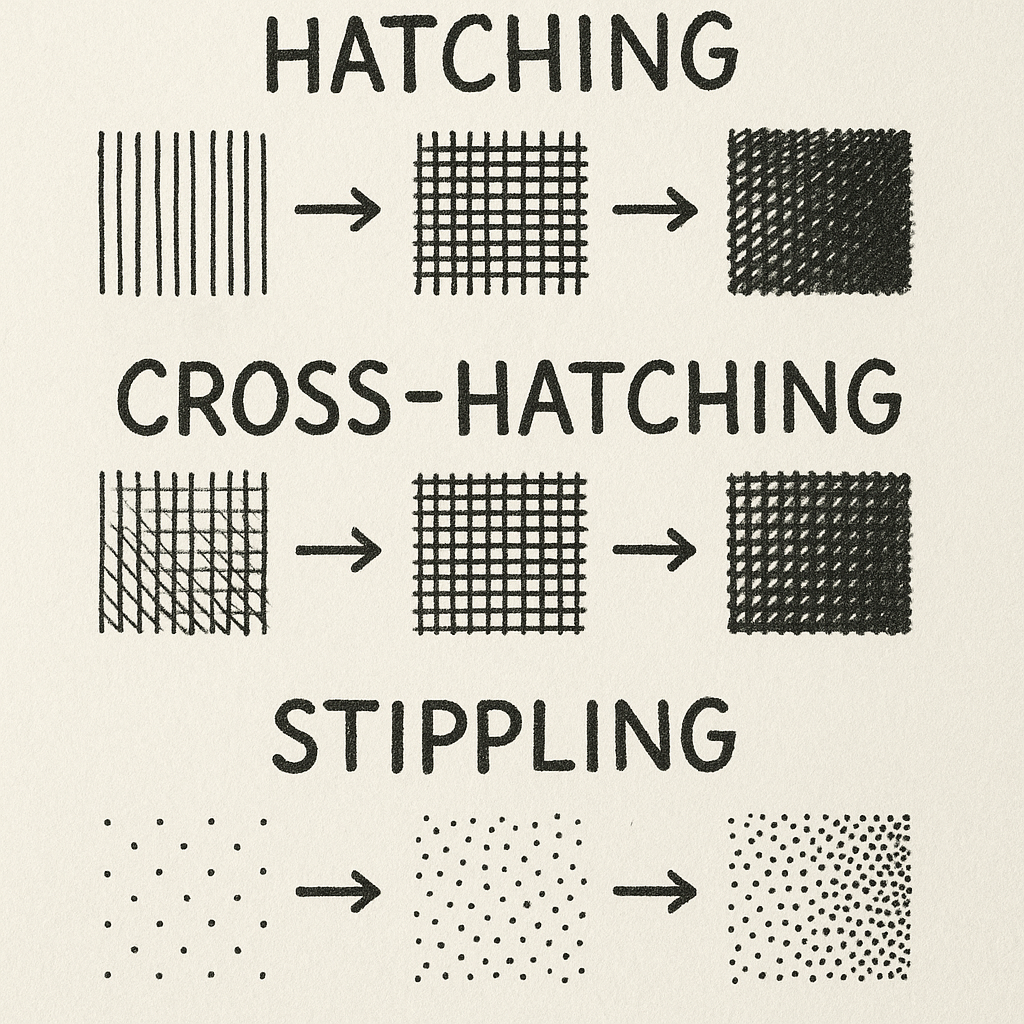
For aspiring artists, understanding the difference between sketching and drawing can be crucial for building a strong foundation in visual art. While these terms are often used interchangeably, they represent distinct approaches to creating art, each with its own purpose, techniques, and benefits for beginners.
Understanding the Core Differences
What is Sketching?
Sketching is a rapidly executed freehand drawing that is not usually intended as a finished work1. It serves as a visual tool for capturing ideas, exploring concepts, and practicing observation skills. Sketching is characterized by its spontaneous, loose, and exploratory nature. The primary purpose is to capture the essence of a subject quickly, focusing on basic forms, shapes, and gestures rather than intricate details.
Key characteristics of sketching include:
- Quick execution with emphasis on capturing ideas rapidly
- Loose, spontaneous lines and minimal detail
- Focus on essential forms and proportions
- Often serves as preliminary work for more detailed pieces
- Emphasis on experimentation and exploration
What is Drawing?
Drawing is a more refined and detailed form of visual art that involves creating marks on a surface using various instruments. Unlike sketching, drawing typically involves more time, precision, and attention to detail. It represents a more finished approach to art-making, where the artist focuses on accuracy, realism, and polished execution.
Key characteristics of drawing include:
- More time-intensive and deliberate process
- Greater attention to detail and refinement
- Focus on accuracy and realistic representation
- Often intended as finished artwork
- Emphasis on precision and technical skill

Visual comparison between loose sketching and detailed drawing
The Technical Differences
The differences between sketching and drawing extend beyond just execution speed. Drawing is fundamentally about “the linear realization of visual objects, concepts, emotions, and fantasies, including symbols and even abstract forms”. It’s characterized by the central use of form, shape, lines, and sometimes patterns. Sketching, on the other hand, prioritizes the expression of ideas and emotions over the pursuit of realism and detail.
The Benefits of Sketching for Beginners
Develops Creative Thinking
Sketching builds new connections in the brain and enhances creative thinkinga unique way and be willing to take a the . During observational sketching, artists slow down and notice new details, gaining insight into how artwork was made. This process helps develop the ability to see something in an original way and be willing to leap into the unknown.
Improves Motor Skills and Coordination
A sketching habit strengthens fine motor skills and hand-eye coordination. New pathways form and, according to studies, increase blood flow to the reward center in the brain. Artists train their eyes to deliver visual information to their brain, which then communicates with their hand.
Builds Confidence
Sketching allows for easy correction of mistakes, making it simple to adjust without leaving visible marks. This helps build confidence in young artists and encourages experimentation. The ability to erase and try again promotes a positive attitude toward the drawing process.
Enhances Observation Skills
Sketching trains the eye to see the world more attentively. Artists develop the ability to perceive subtle nuances, textures, and relationships between objects. This keen observation skill extends beyond the artistic realm and can be beneficial in various fields.

Beginner artist learning to sketch with pencil on paper
Promotes Learning and Exploration
Sketching enables the mind to think in a unique manner, encouraging open-minded thoughts and creativity. When doing uninterrupted sketching, it leads to personal development and problem-solving skills, improving critical thinking abilities.
Where Should Beginners Start?
Why Sketching is Ideal for Beginners
Most art educators recommend that beginners start with sketching before moving to more detailed drawing Sketching is ideally suited for beginners because it:
- Requires minimal investment: Basic sketching materials are inexpensive and accessible
- Encourages experimentation: The loose nature of sketching allows for mistakes and learning
- Builds foundational skills: Sketching develops essential observation and hand-eye coordination
- Reduces pressure: Less emphasis on perfection allows for creative exploration
- Develops confidence: Quick results and easy corrections build artistic confidence
The Learning Progression
Beginners should ideally try to learn how to sketch before either drawing or painting19. Sketching is a valuable skill that provides the foundation for more advanced artistic pursuits19. A good art class, no matter drawing or painting, will also teach sketching fundamentals19.
The progression typically follows this pattern:
- Basic sketching to capture ideas and practice observation
- More detailed sketching to refine technique
- Finished drawing with attention to detail and precision
- Advanced techniques and specialized mediums
Essential Sketching Materials for Beginners
Basic Supply List
Beginners don’t need expensive equipment to start sketching effectively. The essential materials include:
Pencils: A basic set with HB or 2B pencils for general sketching, plus a 6B for darker values. Three pencils (2H, 2B, and 6B) are sufficient for beginners to sketch and shade from very light to very dark.
Paper: A sketchbook or drawing pad with paper suitable for drawing or sketching, weighing at least 60 pounds or 90 GSM. Look for acid-free paper for longevity.
Eraser: A kneaded (putty) eraser is recommended as it picks up unwanted marks rather than smudging the pencil around.
Sharpener: A basic pencil sharpener to maintain sharp points.

Essential sketching materials and tools for beginners
Budget Considerations
Everything needed to start sketching should cost under Rs. 1000, and it’s possible to get decent materials for under Rs. 500. The reality is that practice, not fancy pencils, makes a good artist. Beginners should focus on developing skills rather than acquiring expensive materials.
Basic Sketching Techniques for Beginners
Fundamental Exercises
Line Practice: Start with basic line exercises including straight lines, curves, and circles. Practice drawing lines of varying thickness and quality.
Shape Construction: Begin with basic shapes like circles, squares, and triangles, as most objects can be broken down into these fundamental forms.
Gesture Drawing: Practice quick sketches that capture the essence of a subject in just a few lines. This develops the ability to see and record essential information quickly.
Shading Techniques
Hatching: Create patterns of parallel lines to convey shape, volume, depth, and texture2.
Cross-Hatching: Use networks of lines at different angles to create darker values.
Stippling: Apply dots to create shading effects, with closer dots creating darker areas.

Basic shading techniques for sketching practice
Practice Recommendations
Daily Practice: Maintain a regular sketching practice, even if just for 10-15 minutes per day. Keep a sketchbook for daily use to track progress.
Observational Sketching: Draw from real objects and scenes rather than relying solely on imagination or photographs3534. This develops crucial observation skills.
Start Simple: Begin with simple subjects like basic geometric shapes, household objects, or still life arrangements. Avoid complex subjects initially to build confidence.
The Role of Sketching in Artistic Development
Foundation Building
Sketching forms the foundation for all visual arts. It serves as the basis for more complex artworks, whether paintings, illustrations, or detailed drawings. Every painting is essentially built up of lines and pre-sketched in its main contours.
Skill Transfer
The skills developed through sketching transfer to other artistic mediums. Understanding perspective, proportion, light behavior, and form through sketching improves painting and other artistic endeavors.
Creative Development
Sketching helps identify personal artistic style and enlightens artists about critical aspects required in art such as shape, form, light, and shadow. It provides a foundation for exploring creativity and developing unique artistic voice.
When to Transition to Detailed Drawing
Signs of Readiness
Beginners should consider transitioning to more detailed drawing when they:
- Feel comfortable with basic sketching techniques
- Can consistently capture proportions and basic forms
- Have developed adequate hand-eye coordination
- Want to explore more finished, polished artwork
The Natural Progression
The transition from sketching to drawing often happens naturally as artists become more confident5. Many artists use sketching as the preliminary stage for more detailed work. The sketch provides the foundation upon which more detailed and refined work is built.
Common Misconceptions
“Sketching is Just Practice”
While sketching serves as excellent practice, it’s also a legitimate art form in its own right17. Many sketches are beautiful works of art, and contemporary taste often values sketches as highly as finished works7.
“You Need Expensive Materials to Start”
This is one of the most common misconceptions among beginners. Basic, inexpensive materials are perfectly adequate for learning to sketch. The focus should be on developing skills rather than acquiring expensive equipment.
“Perfection is the Goal”
Sketching is about exploration, experimentation, and capturing essence rather than achieving perfection. Embracing mistakes and imperfections is part of the learning process.
Conclusion
For beginners embarking on their artistic journey, sketching provides the ideal starting point. It offers a low-pressure environment for developing fundamental skills while building confidence and creative thinking abilities. The spontaneous, exploratory nature of sketching allows new artists to focus on observation and basic techniques without the pressure of creating finished masterpieces.
While drawing represents the more refined, detailed approach to visual art, it builds upon the foundation that sketching provides. The progression from quick, loose sketches to detailed, finished drawings is a natural evolution in artistic development.
The key for beginners is to start simple, practice regularly, and embrace the learning process. With basic materials and consistent practice, sketching can open the door to a lifelong journey of artistic expression and creative growth. Whether sketching remains a preferred medium or serves as a stepping stone to more detailed work, it provides invaluable benefits for developing artists at any stage of their journey.
- https://memorialize.art/blogs/news/sketching-vs-drawing
- https://en.wikipedia.org/wiki/Sketch_(drawing)
- https://artfromthestreets.org/blogs/news/what-is-drawing
- https://www.animationcoursesahmedabad.com/blog/ahmedabad/3d-animation/difference-between-drawing-and-sketching/62/details
- https://www.domestika.org/en/blog/11174-the-art-of-sketching
- https://www.artsindia.com/blogs/news/what-is-drawing-in-art
- https://paintinglessonswithmarla.com/114-differences-between-sketching-and-drawing/
- https://www.britannica.com/art/sketch-art
- https://en.wikipedia.org/wiki/Drawing
- https://www.whataportrait.com/blog/sketching-vs-drawing-major-differences/
- https://sampratishta.org/sketching-the-fundamental-of-painting/
- https://www.britannica.com/art/drawing-art
- https://www.edenart.com/news/drawing-vs-sketching
- https://www.designindex.org/definitions/design/sketch.html
- https://ideelart.com/blogs/magazine/what-is-drawing
- https://www.reddit.com/r/ArtistLounge/comments/172dp79/curious_to_know_what_everyone_thinks_is_their/
- https://schoolofsketching.com/blog-in-english/sketchingwhatisit
- https://artsandculture.google.com/entity/drawing/m02csf?hl=en
- https://www.youtube.com/watch?v=MwyMxZ9Zpnk
- https://library.fiveable.me/key-terms/drawing-foundations/sketching
- https://www.skillshare.com/en/blog/21-quick-drawing-tips-thatll-improve-your-skills/
- https://www.reddit.com/r/learnart/comments/7m7vgb/looking_to_get_into_drawing_where_do_i_start/
- https://www.instructables.com/Sketching-Drawing-Lessons/
- https://juliabausenhardt.com/how-to-draw-anything-learn-sketching-for-beginners/
- https://www.reddit.com/r/learntodraw/wiki/index/
- https://shop.zenartsupplies.co/blogs/toolkit/sketching-techniques-for-beginners
- https://bingedrawing.com/basics/how-to-draw/
- https://www.adobe.com/in/creativecloud/illustration/discover/learning-to-draw.html
- https://bingedrawing.com/techniques/basic-drawing-techniques/
- https://www.reddit.com/r/drawing/comments/qrjhjj/hey_im_trying_to_learn_how_to_draw_any_tips_for/
- https://monikazagrobelna.com/2020/08/09/i-want-to-draw-but-i-dont-know-how-to-start/
- https://www.cowlingandwilcox.com/blog/post/48-a-guide-to-pencil-sketching-techniques
- https://www.youtube.com/watch?v=XeIR7P82aPU
- https://www.youtube.com/watch?v=VtgB2pCC73M
- https://www.youtube.com/watch?v=b2scvHu_tGQ
- https://www.creativebloq.com/illustration/sketching-tips-beginners-81516497
- https://www.youtube.com/watch?v=2K5uA5oqFTc
- https://www.youtube.com/playlist?list=PLDcVY7tIUDzsNR5AjIzqyiN2P85TKAWvb
- https://www.youtube.com/playlist?list=PL7oW-rwpz64KmRYD0GyRt5wFLhHfVqkJ3
- https://www.youtube.com/watch?v=2szSyXx8cZQ
- https://www.reddit.com/r/ArtistLounge/comments/14h5e1s/beginner_in_arts_paint_or_draw/
- https://www.reddit.com/r/ArtistLounge/comments/169t69i/is_it_easier_to_sketching_traditionally_vs/
- https://callistyle.in/blog/difference-between-sketching-and-drawing/
- https://www.miicreative.com/blogs/painting/what-s-better-for-beginners-painting-vs-drawing
- https://bingedrawing.com/basics/learn-to-draw-first/
- https://www.youtube.com/watch?v=tWAb1K5UQlk
- https://www.youtube.com/watch?v=8vIM3I_mzQM
- https://bingedrawing.com/basics/why-drawing-is-so-hard/
- https://www.wildlifeartstore.com/is-drawing-harder-than-painting/
- https://theartandbeyond.com/pencil-drawing-for-beginners/
- https://www.famsf.org/stories/6-reasons-to-sketch
- https://www.studiociaclasses.com/blog/blog-post-title-two-634jf
- https://artvillaacademy.com/7-important-steps-to-master-sketching/
- https://www.awberyart.com/blog/sketching
- https://pencilandchai.com/why-sketching-is-important-before-painting/
- https://www.youtube.com/watch?v=3U5B8kCsvME
- https://www.youtube.com/watch?v=0XyPYPgXl2M
- https://www.superprof.co.in/blog/why-take-drawing-lessons/
- https://in.indeed.com/career-advice/career-development/how-to-improve-drawing-skills
- https://susanchiang.com/blog/3-benefits-of-sketching-before-painting
- https://www.youtube.com/watch?v=fR07wJJIBwI
- https://bingedrawing.com/basics/benefits-of-learning-how-to-draw/
- https://www.erikalancaster.com/art-blog/why-knowing-how-to-draw-will-improve-your-painting
- https://www.lizsteel.com/benefits-of-sketching-regularly/
- https://emptyeasel.com/2017/04/11/what-are-the-advantages-or-disadvantages-of-drawing/
- https://www.artiststrong.com/what-are-the-benefits-of-drawing/
- https://www.hellosimply.com/blog/simply-draw/should-you-learn-to-draw-realistically-first-a-guide-for-aspiring-artists/
- https://www.reddit.com/r/ArtistLounge/comments/15u8crr/art_supplies_for_a_beginner/
- https://artsuppliesaustralia.com.au/blogs/posts/7-must-have-art-supplies-for-beginners
- https://sibleyfineart.com/tutorial–pencil-drawing-tools.htm
- https://bbag.in/blogs/stationery/beginner-s-guide-to-drawing-sketching-essentials-for-new-artists
- https://altenew.com/pages/10-must-have-art-supplies-for-beginners
- https://artventurebyandleeb.com/drawing-tools/
- https://emilysnotebook.co.uk/all-posts/sketching-materials-for-beginners/
- https://www.youtube.com/watch?v=n54uJHAVE2g
- https://www.meesho.com/professional-sketching-drawing-art-tool-kit-with-graphite-pencils-charcoal-pencils-paper-erasable-pen-craft-knife-lightwish-35-pc-art-sketching-kit-graphite-charcoal-drawing-pencil-set-for-artist-kit-painting-shading-sketch-kit-for-kids-and-adults-with-zipper-carry-case/p/2v9sl8
- https://thevirtualinstructor.com/blog/10-essential-drawing-materials-and-tools-for-beginners
- https://www.flipkart.com/kraptick-29-pieces-professional-sketching-drawing-art-tool-kit-graphite-pencils-charcoal-paper-erasable-pen-craft-knife-lightwish-with-canvas-rolling-pouch/p/itmf7yzfjhuezqvg
- https://www.carandache.com/ch/en/drawing-supplies
- https://kdsartstore.com/product-category/art-material/drawing-sketching/drawing-tools-equipment/
- https://www.youtube.com/watch?v=Kd-eCn_beF0
- https://www.pinterest.com/ideas/drawing-tools-sketching/912174135807/
- https://www.toadhollowstudio.com/wp_blog/drawing-supply-lists/
- https://www.artlessonsonline.com.au/basic-drawing-materials/
- https://www.artlounge.in
